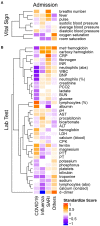Comparing COVID-19 and Influenza Presentation and Trajectory
- PMID: 34055833
- PMCID: PMC8160103
- DOI: 10.3389/fmed.2021.656405
Comparing COVID-19 and Influenza Presentation and Trajectory
Abstract
Background: COVID-19 is a newly recognized illness with a predominantly respiratory presentation. It is important to characterize the differences in disease presentation and trajectory between COVID-19 patients and other patients with common respiratory illnesses. These differences can enhance knowledge of pathogenesis and help in guiding treatment. Methods: Data from electronic medical records were obtained from individuals admitted with respiratory illnesses to Rambam Health Care Campus, Haifa, Israel, between October 1st, 2014 and October 1st, 2020. Four groups of patients were defined: COVID-19 (693), influenza (1,612), severe acute respiratory infection (SARI) (2,292), and Others (4,054). The variable analyzed include demographics (7), vital signs (8), lab tests (38), and comorbidities (15) from a total of 8,651 hospitalized adult patients. Statistical analysis was performed on biomarkers measured at admission and for their disease trajectory in the first 48 h of hospitalization, and on comorobidity prevalence. Results: COVID-19 patients were overall younger in age and had higher body mass index, compared to influenza and SARI. Comorbidity burden was lower in the COVID-19 group compared to influenza and SARI. Severely- and moderately-ill COVID-19 patients older than 65 years of age suffered higher rate of in-hospital mortality compared to hospitalized influenza patients. At admission, white blood cells and neutrophils were lower among COVID-19 patients compared to influenza and SARI patients, while pulse rate and lymphoctye percentage were higher. Trajectories of variables during the first 2 days of hospitalization revealed that white blood count, neutrophils percentage and glucose in blood increased among COVID-19 patients, while decreasing among other patients. Conclusions: The intrinsic virulence of COVID-19 appeared higher than influenza. In addition, several critical functions, such as immune response, coagulation, heart and respiratory function, and metabolism were uniquely affected by COVID-19.
Keywords: COVID-19; SARI; biomarkers; disease trajectory; influenza.
Copyright © 2021 Reiner Benaim, Sobel, Almog, Lugassy, Ben Shabbat, Johnson, Eytan and Behar.
Conflict of interest statement
The authors declare that the research was conducted in the absence of any commercial or financial relationships that could be construed as a potential conflict of interest.
Figures





Similar articles
-
[Clinical characteristics of hospitalized severe acute respiratory illnesses (SARI) in children and risk factors analysis of severe illness: results from SARI patients under 15-year-old of sentinel surveillance in 10 cities, China].Zhonghua Yu Fang Yi Xue Za Zhi. 2015 Jun;49(6):534-40. Zhonghua Yu Fang Yi Xue Za Zhi. 2015. PMID: 26310340 Chinese.
-
Description and comparison of demographic characteristics and comorbidities in SARI from COVID-19, SARI from influenza, and the Brazilian general population.Cad Saude Publica. 2020;36(7):e00149420. doi: 10.1590/0102-311x00149420. Epub 2020 Jul 24. Cad Saude Publica. 2020. PMID: 32725087 English, Portuguese.
-
Epidemiologic Profile of Severe Acute Respiratory Infection in Brazil During the COVID-19 Pandemic: An Epidemiological Study.Front Microbiol. 2022 Jul 1;13:911036. doi: 10.3389/fmicb.2022.911036. eCollection 2022. Front Microbiol. 2022. PMID: 35854935 Free PMC article.
-
Epidemiology and costs of severe acute respiratory infection and influenza hospitalizations in adults with diabetes in India.J Infect Dev Ctries. 2019 Mar 31;13(3):204-211. doi: 10.3855/jidc.10903. J Infect Dev Ctries. 2019. PMID: 32040449
-
Clinical characteristics and factors associated with severe acute respiratory infection and influenza among children in Jingzhou, China.Influenza Other Respir Viruses. 2017 Mar;11(2):148-156. doi: 10.1111/irv.12419. Epub 2016 Sep 20. Influenza Other Respir Viruses. 2017. PMID: 27465959 Free PMC article.
Cited by
-
Differences in clinical characteristics between coronavirus disease 2019 (COVID-19) and influenza: a systematic review and meta-analysis.NPJ Prim Care Respir Med. 2025 Jan 28;35(1):8. doi: 10.1038/s41533-025-00414-0. NPJ Prim Care Respir Med. 2025. PMID: 39875405 Free PMC article.
-
Viral mapping in COVID-19 deceased in the Augsburg autopsy series of the first wave: A multiorgan and multimethodological approach.PLoS One. 2021 Jul 19;16(7):e0254872. doi: 10.1371/journal.pone.0254872. eCollection 2021. PLoS One. 2021. PMID: 34280238 Free PMC article.
-
How to organise a datathon for bridging between data science and healthcare? Insights from the Technion-Rambam machine learning in healthcare datathon event.BMJ Health Care Inform. 2023 Sep;30(1):e100736. doi: 10.1136/bmjhci-2023-100736. BMJ Health Care Inform. 2023. PMID: 37696642 Free PMC article. No abstract available.
-
Prediction of COVID-19-related Mortality and 30-Day and 60-Day Survival Probabilities Using a Nomogram.J Korean Med Sci. 2021 Sep 6;36(35):e248. doi: 10.3346/jkms.2021.36.e248. J Korean Med Sci. 2021. PMID: 34490756 Free PMC article.
-
Comparison of COVID-19 with influenza A in the ICU: a territory-wide, retrospective, propensity matched cohort on mortality and length of stay.BMJ Open. 2023 Jul 10;13(7):e067101. doi: 10.1136/bmjopen-2022-067101. BMJ Open. 2023. PMID: 37429680 Free PMC article.
References
LinkOut - more resources
Full Text Sources
Other Literature Sources
Miscellaneous

